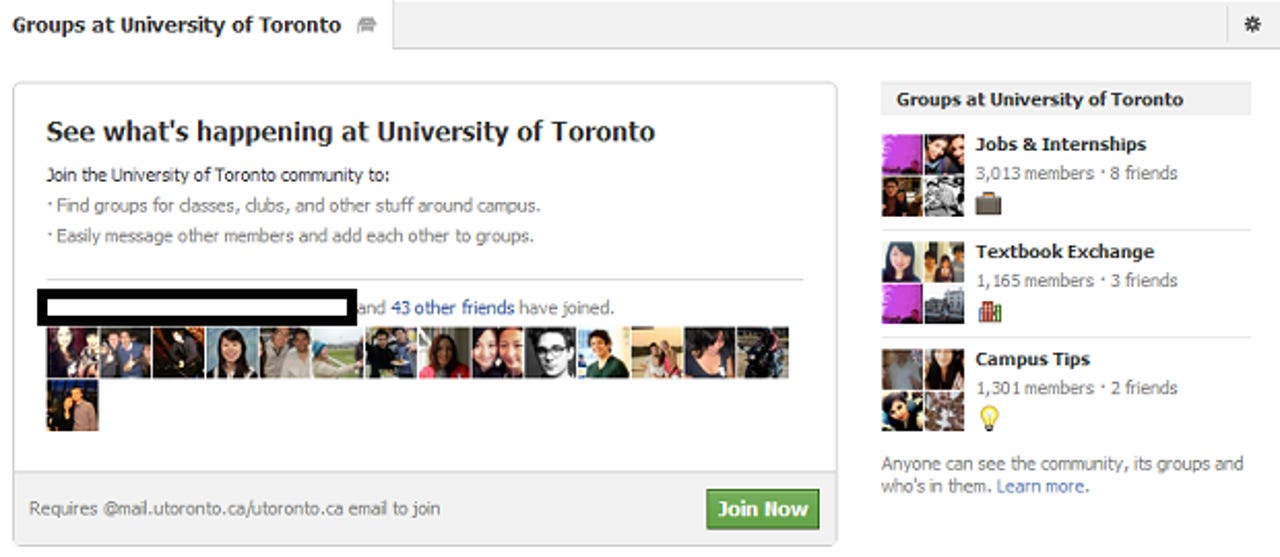Facebook launches Groups for Schools

As expected, Facebook today launched Groups for Schools, which allow people with an active school e-mail address to join groups at their college or university. You can join a group for your major to discuss classes, for your sorority to plan upcoming events, or for your dorm to share photos. Facebook says file sharing for these groups is coming, to make it even easier to share lecture notes, sports schedules, or class assignments.
Facebook is rolling out Groups for Schools gradually to colleges and universities around the world. To find your school, head over to the Groups for Schools webpage.
Facebook first started out as an exclusive service for Harvard students, then expanded to more universities and colleges, and only after opened up to the whole world. Since signing up for Facebook once required a university or college e-mail address, users felt safer sharing openly with everyone in their school's network. With Groups for Schools, Facebook is going back to its roots since you must have an official e-mail account with your school to join.
Anyone part of the Facebook Group can create subgroups (for classes, clubs, dorms, sport teams, student organizations, parties, and so on) that are only visible to those with an authenticated school e-mail address. For most schools in the U.S., that means an e-mail address ending with edu.com, but Facebook acknowledges that many universities and colleges don't follow this rule and so it simply requires that members have an e-mail address with whatever domain the school requires (in my case it's @utoronto.ca).
Here's how Facebook describes the new feature:
Your Student Life, All in One Place
- Join groups, see photos and plan events around campus
- Add classmates to groups without having to be friends first
- Exclusive to members of the University of Toronto community
Facebook first started testing the new Groups in December 2011 (with Groups at Brown and Groups at Vanderbilt). Last month, however, I and many of my classmates were invited to Groups at University of Toronto. Annoyingly, just being part of UofT meant I got a "Groups at University of Toronto" section in the Groups menu on the left-hand side of my Facebook account, even if I chose not to join the Group. Unlike other groups, there was no way to remove it.
Facebook has fixed this now. While the entry still appears on the left side of my account, I can remove myself by clicking the pencil icon next to the group name, or by going to the group and removing myself from the gear icon. Here's the message I got when I did so: "Are you sure you do not want to join Groups at University of Toronto? If you change your mind, you will have to visit the group page directly. Members will not be able to add you to the group."
Still, it's annoying that you automatically get the entry. Facebook is likely hoping this won't be a problem because it clearly wants all students to join the group for their corresponding school.
As you can see in the screenshot above, 45 of my friends have already joined Groups at University of Toronto. Don't get me wrong: I think the new feature is a brilliant idea, but I like having complete control over my Facebook account. I'll join the Group if and when I want to, not when Facebook wants me to.
Check out the Facebook Help Center for more information about the new feature. If you're seeing it, you can give your feedback (suggestions and bug reports) via the following two forms: Your School Groups Suggestion and Something's Not Working: School Groups.
The new Groups for Schools feature is Facebook's way of catering to its original audience. Given that the service has grown to over 845 million monthly active users, Menlo Park realizes that students are no longer just friends with other students on the social network. Their families, colleagues, and other friends may not necessarily want to hear about their academic lives.
For sharing content, students can just use Friend Lists to organize their different types of friends, but for everything else school-related they may want to do on Facebook, there hasn't been a clear separator, until now. Facebook wants people using the service for every type of communication, and Groups for Schools is an attempt to get students back to doing just that.
See also:
- School district demands Facebook password, 12-year-old girl sues
- Facebook can be used to predict academic success, job performance
- British student jailed for hacking into Facebook
- Students' Facebook photos posted to porn site, FBI investigates
- Teacher should be fired for Facebook comment, judge rules
- Law repealed: teachers can be Facebook friends with students
